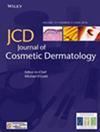Skin aging results in skin barrier damage and skin wrinkles. Oral Colla Corii Asini (CCA) can show significant antiaging effects. However, few studies have investigated the skin's antiaging effects of topical CCA. Here, we investigated and compared the effects of CCA crushed (CCAC) and its enzymatic digest, CCA oligopeptide (CCAO), on skin barrier function and wrinkle formation.
CCAO and CCAC were prepared by enzymatic digestion and pulverization. HaCaT cells and HSF cells were selected as in vitro cell models. Cytotoxicity and cell proliferation were detected by MTT assay; scratch assay was used to evaluate the effect on cell migration; quantitative real-time PCR (qRT-PCR), immunofluorescence, and ELISA were used to determine the changes in expression of the barrier-related molecules (AQP3, FLG, and LOR) and antiwrinkle firming-related molecules (COL-1, COL-3, ELN, and MMP-1).
MTT assay showed no significant cytotoxicity of CCAO and CCAC at < 2.5 mg/mL. After treating the cells with safe doses of CCAO and CCAC, HaCaT cell proliferation and migration were significantly enhanced, and there was no difference between the two effects. The expression levels of AQP3, FLG, and LOR were all significantly increased compared with the NC group, in which CCAO mainly promoted FLG and LOR expression, while CCAC mainly promoted the expression of AQP3. At the same time, CCAO and CCAC also significantly upregulated the expression levels of COL-1, COL-3 and ELN, and downregulated MMP-1 expression in HSF cells, and the effect of CCAO was more significant.
Topical application of CCA improves the skin barrier, increases collagen levels, and enhances skin elasticity, thus slowing down skin aging. CCAO is more easily absorbed and utilized by the skin due to its small molecular weight, which gives a better effect.



